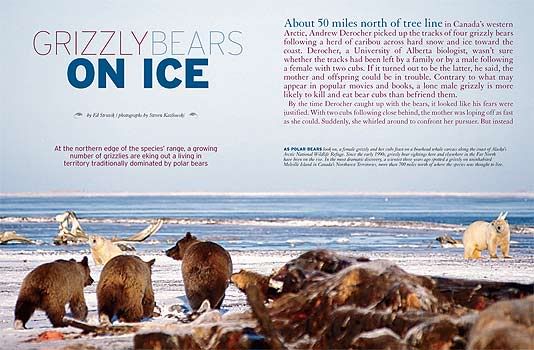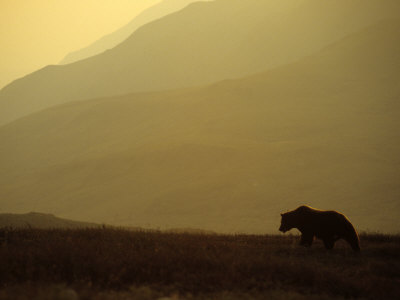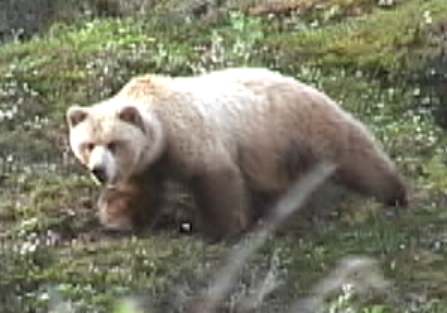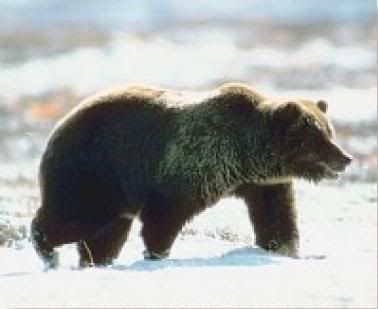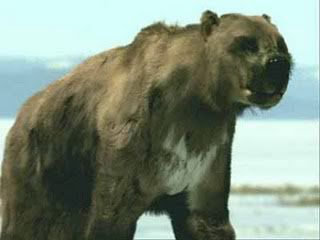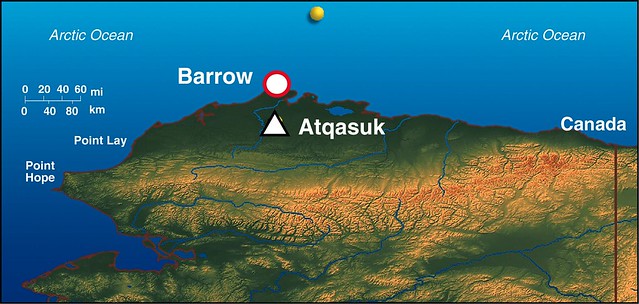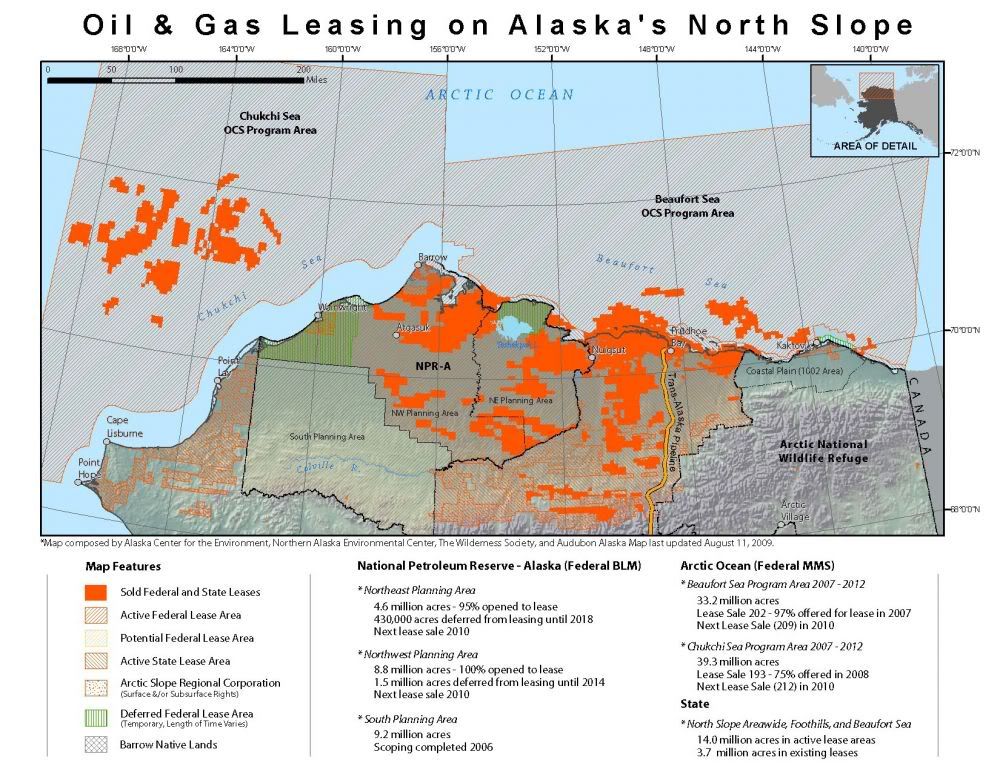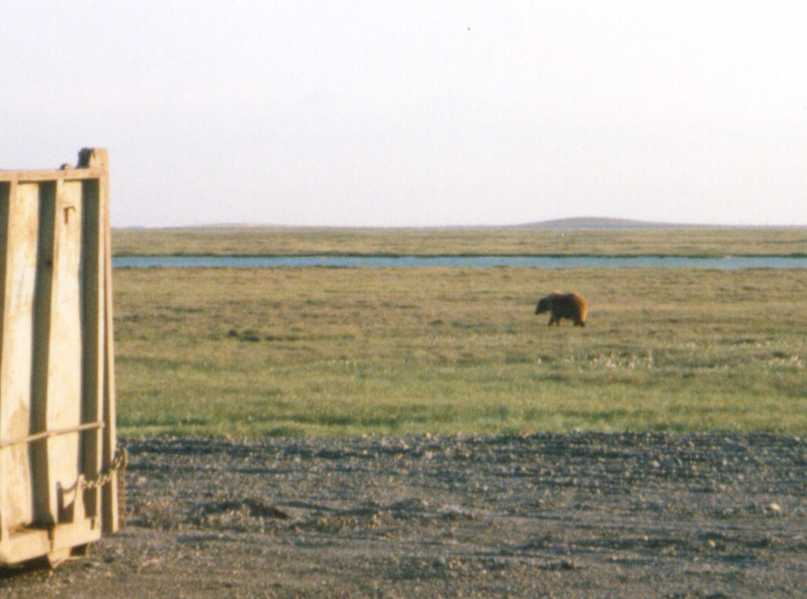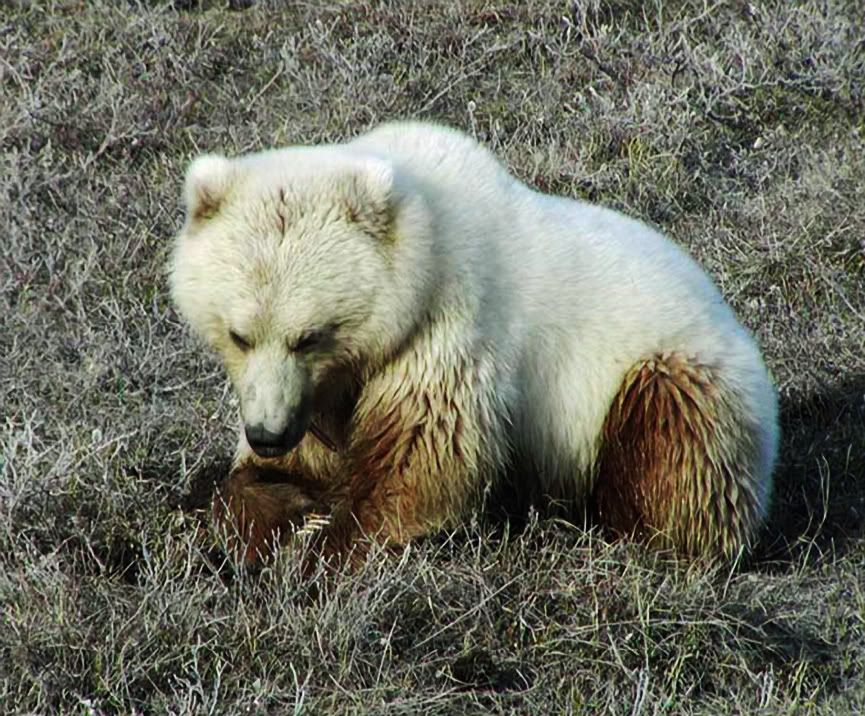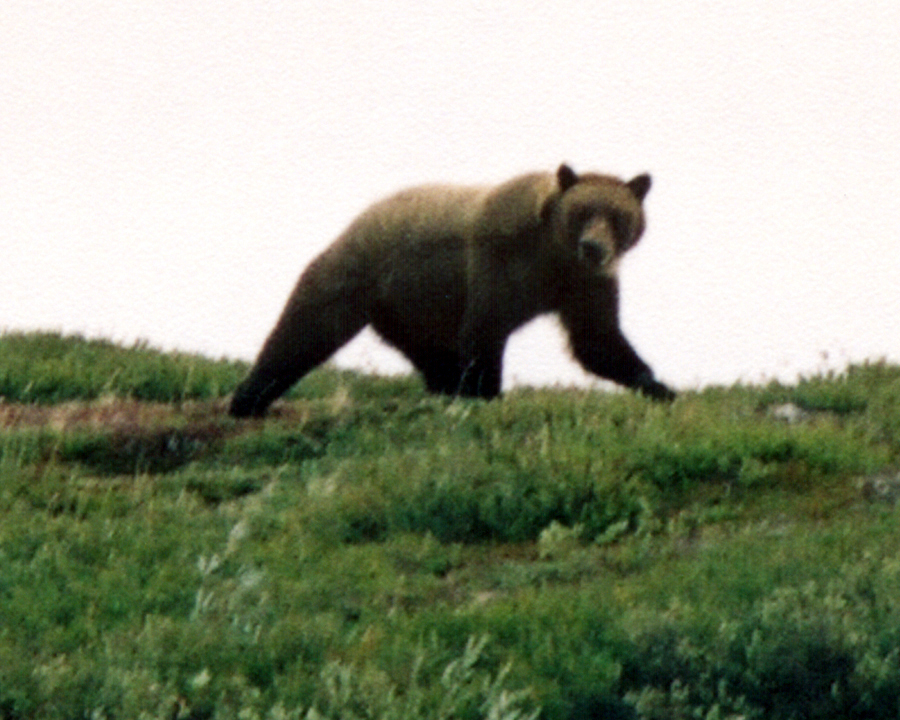ANWR Grizzly Attacks: They Did Everything Right
A rare grizzly attack in the Arctic National Wildlife Refuge may be a sign of more than just bear trouble.
On the afternoon of June 25, Robert Thompson, an Inupiat rafting guide, was floating with two clients down the Hulahula River in Alaska's Arctic National Wildlife Refuge (ANWR) when he observed a blond adult grizzly bear lording over a wrecked campsite in an alcove beneath a low tundra bluff. Thompson could see scattered gear, a mangled tent, and the shredded remains of two inflatable kayaks. He hoped the campers were off somewhere hiking.
When he stopped the raft to get a better look, the bear suddenly charged. Thompson and his clients paddled frantically away, but the bear splashed into the river and began swimming after them. For half a mile (.8 kilometers) the bear alternately swam, clambered to shore, and ran after the raft. It was gaining on them.
When it got within 40 feet (12 meters), the seasoned guide yanked his handgun from his drybag, but resisted the impulse to fire a warning shot, opting instead to save his bullets in case he had to drop it. But just then, the fast water slammed the grizzly into a boulder, which it climbed on to, snuffing at the rafters from this perch as the swift current carried them downriver. It continued the pursuit, half-heartedly now, and after 15 terrifying minutes, it finally gave up the chase. A shaken Thompson called for help on his satellite phone.
Since the wildlife refuge's creation in 1960, only one person has been injured by bears within its 19.6 million acres; none have sustained bear-related injuries in the past two decades. But then, few people used to visit the area—something that's changed dramatically in recent years as the region, known throughout the lower 48 as ANWR and by locals simply as "the refuge," has become the subject of national debate. Each time the specter of Alaska oil drilling is raised in Washington, D.C., the number of visitors goes up: from 679 prior to 2000 to an annual average of 1,010 in 2004, not counting frequent trips by local indigenous people. Last spring Congress approved a preliminary budget resolution with provisions for drilling in the sanctuary. Throughout the summer, hundreds of rafters arrived to rollick down its bouldered rivers.
"It wouldn't surprise me if we see an increase again because we're in the news more," said Joanna Fox, assistant refuge manager for the Arctic National Wildlife Refuge. "A lot of people are interested in seeing the area in case oil development comes."
However, unbeknownst to the scores of new visitors, this tundra is home to an opportunistic predator that has come to demand more and more respect. In local vernacular, it's known as the barren ground grizzly, and it's a different order of bear altogether.
Backcountry VeteransKathy and Rich Huffman had been eagerly anticipating their own paddling trip, a romantic, ten-day kayaking run down the Hulahula, timed to beat the mosquitoes and, more importantly, to coincide with their 16th wedding anniversary. Rich, 61, a utilities lawyer, and Kathy, 58, a retired schoolteacher, both from Anchorage, were careful and experienced backcountry travelers. Bush pilot Tom Johnston of Alaska Flyers in Kaktovik, an Inupiat village on the shores of the Beaufort Sea, said he had never had a passenger grill him as Kathy did about his experience, his flight hours, and his airplane's emergency equipment. She insisted that Johnston show her where everything was stowed, and made a point of asking for both his dispatcher's and the state trooper's phone numbers.
While loading the Huffmans' gear into his wheeled Cessna 206, Johnston saw an EPIRB (emergency position indicating radio beacon), two pepper spray canisters, bearproof food containers, drybags that were worn but in good repair, and a rifle packed in a soft case. The only concern Kathy expressed openly was for the Hulahula's rapids, which, after a flyover, she felt confident she could handle.
On June 23, eight days into their trip, they landed their inflatable kayaks and made camp on the edge of the refuge's coastal plain. As was their habit, they cooked miles upriver of camp and meticulously stowed their food and toothpaste away from their tent in bearproof containers. And, like most savvy Alaskans, they went to sleep that night next to their insurance policy: a 45-70 lever action CoPilot rifle. They never had a chance to use it.
In the early morning, a 300-pound, blond male grizzly happened upon the camp. It could probably sense that this was a small group. (According to Stephen Herrero's seminal work, Bear Attacks: Their Causes and Avoidance, bears will rarely attack a group of three or more. A group of six or more has never been attacked.) The grizzly may have curiously swiped at the tent with its daggered claws and then reacted to the inevitable commotion inside. Or, even more disturbingly, it may have intended to kill and eat the Huffmans from the beginning.
Not Your Average Griz Although genetically identical to the eight-foot, 900-pound coastal brown bears of southern Alaska, the barren ground grizzly rarely tops six feet and 500 pounds. A scarcity of food in northern Alaska makes these grizzlies smaller, and they behave very differently from coastal brown bears. Well-fed brown bears sleep a lot and shamble around a ten-square-mile territory. In contrast, hungry barren ground grizzlies can prowl 5,000-square-mile territories, constantly sniffing the air for scent. In the Arctic—where there are no streams filled with fat salmon, no forests to provide shade or cover, and food gathering is cut short by the long winters—the omnivorous barren ground's mission is simple: relentlessly hunt down and consume every available scrap of food.
Roots and sedges help them fend off starvation, but for thousands of years these grizzlies have preferred meat, found in fresh supply at the movable feasts that are Alaska's legendary caribou herd migrations. Each June on the refuge's coastal plain, caribou herds birth up to 60,000 calves, and bears can kill up to six newborns a day. But this meat supply has been dwindling as the effects of climate change become manifest in the Arctic, and the habitually famished grizzlies are finding themselves in even more desperate straits.
According to a 2002 U.S. Geological Survey report, increased spring snow and ice—a paradoxical result of global warming trends—is burying the coastal plain plants essential to caribou and grizzly diets. The caribou are decreasing in number or seeking grazing land elsewhere, and the barren ground grizzlies, bereft of this supplemental protein, have been stalking the tundra for alternatives. U.S. Fish and Wildlife Service biologist Patricia Reynolds notes that over the past five or six years, the refuge's musk ox population has dwindled from around 300 to no more than 50. As human traffic increases in the refuge, one can only wonder if grizzlies might test them as new prey.
"That grizzly is more aggressive than the coastal brown bear," says Will Troyer, who began live-trapping bears in Alaska in the 1950s. "When I first went up there, you never saw anybody in that country except for the Eskimos. Now the climate is getting warmer, and there's more human activity."
Fran Mauer, a recently retired USFWS wildlife biologist, is one of many experts who say that bears could easily kill a lot more people, but don't. From 1900 to 2000, brown bears killed 42 humans in Alaska (polar bears have killed one person in that time; black bears, six). But with more people visiting the North, it will only get more difficult for the emboldened barren ground grizzly to avoid human encounters. A day before the Huffmans were discovered, the bush pilot who dropped Mauer off in the refuge asked if he was packing a gun because the bears were acting up.
The Freaky ThingThe grizzly was still there when North Slope Borough Search and Rescue pilot Bob Mercier hovered his helicopter over the Huffmans' camp. It was lingering near the couple's remains, which were tangled up in their ruined tent. As the rotor blades churned overhead, the bear ran off but sat a quarter mile away, unwilling to give up his kill. Because there were human fatalities, the pilot flew straight to Kaktovik and picked up Officer Richard Holschen of the North Slope Borough Police Department. On their return, the helicopter again scared the bear away from the bodies, and Mercier was able to touch down so Holschen could investigate.
An initial examination of the scene revealed that Rich Huffman had tried to fend off the bear. He'd released the lever action of his rifle, but never had a chance to pull it back and chamber a round. The couple was likely startled awake and trapped inside their tent with mere seconds to defend themselves. In the three years Holschen had worked in Kaktovik, he had frequently driven polar bears out of town and away from whale carcasses, and they had always run far away. But when he looked up, he was unnerved to see the Hulahula grizzly lumbering back toward the campsite.
Holschen, armed with a shotgun, waited for the bear to come closer. Mercier, meanwhile, revved the Bell 412 into the air, and his co-captain, Randy Crosby, chambered a round in his rifle and dropped the grizzly with four bullets.
The next day, Alaska Department of Fish and Game biologist Dick Shideler arrived to inspect the scene himself. The bear containers had been scuffed and thrown around. Nearly every piece of gear, including the two inflatable kayaks, had been bitten or torn apart. A raw east wind had been blowing the past few evenings, so it seemed likely that the couple had chosen this spot along the river because it sat below a ten-foot-high tundra bluff. Even if the Huffmans weren't in their tent, they likely would not have seen the bear coming. "It was a site I would've picked as an experienced camper," Shideler said, "but as a bear person, I would've walked around and looked for fresh diggings." On the bench above the campsite, where the tents and bodies had been dragged, claw marks showed where a hungry grizzly had repeatedly raked the tundra for bear roots; several ground squirrel holes had been dug up. The tracks matched the dead bear's.
The following week, Shideler performed a necropsy on the bear. It was seven years old and in remarkably good health. It had no scars, no old wounds, not even the expected broken canine from sparring with other males.
For weeks after the mauling, villagers in Kaktovik kept asking Officer Holschen what the Huffmans had done wrong. "The freaky thing," Holschen said, "is that they did most everything right."
Some in the region believe that this was simply a rogue bear, but Shideler dismisses those claims. "This bear was perfectly healthy and following normal predation patterns," he said. Others see a trend afoot. Last summer, Arctic Wild guide Jennifer van den Berg was briefly confronted by a bear that, despite her shouts, showed no fear of humans. Shortly before the Huffmans arrived, backpackers near the eastern boundry were bluff-charged by a grizzly. Whether rogue bear or emerging trend, the Huffman incident underscores the Achilles' heel of all Arctic travelers: being stalked in your tent while asleep on the tundra.
Thompson, the river guide who found the Huffmans' campsite, believes that a floorless tent, an electric fence, and a loaded pistol (that doesn't need to be cocked) might help future campers. "I never take bear food canisters," he said. "If the bear is hungry, he might get ticked off. It's no big deal for him to eat my food instead of me. Some guys stack pots on their food bags so that if a bear comes into camp, the pots fall off and wake them up."
Thompson is an environmentalist in a community that has a long tradition of bear hunting and is divided on the subject of oil development. For five seasons, he has managed to guide without killing a bear. "I've spent my whole life in the wilderness trapping and guiding," he said, "and this is my first close encounter." After the harrowing pursuit that day in June, he vows that he'll shoot to kill the next time he's chased by a barren ground grizzly.
www.nationalgeographic.com/adventure/0510/whats_new/anwr_grizzly_attacks.html



